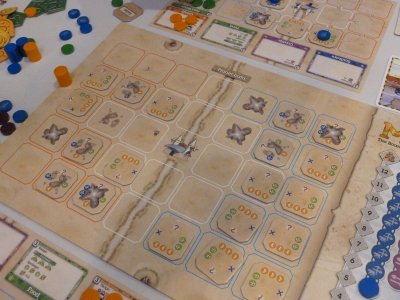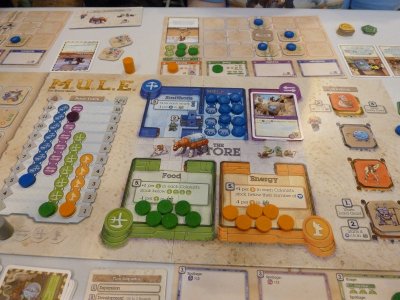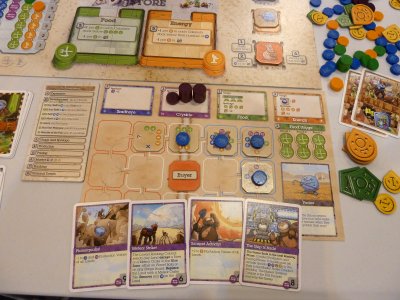

![[IMAGE]](../bilder/mule1.jpg) |
Designers: Publisher: No. of Players: Awards: |
![[IMAGE]](../technik/box/rot/rot-6.gif) ![[IMAGE]](../technik/box/gelb/gelb-10.gif) ![[IMAGE]](../technik/box/grun/grun-7.gif) ![[IMAGE]](../technik/box/pink/pink-7.gif) ![[IMAGE]](../technik/box/blau/blau-10.gif) |
|
Some of you might actually remember that during my reports from the SPIEL '10 and '11 convention I was telling you a bit about an upcoming boardgame version of Dan Bunten's classic computer game M.U.L.E.. 5 years back Heikki had presented the prototype for a boardgame version of M.U.L.E. at the booth of Finnish publisher TUONELA, but it took some more years and a publisher change until the prototype finally was ready for production. Now Heikki Harju is back with the finished game, and LAUTAPELIT finally invites me and many other old school gamers to return to Planet Irata.
So, what's the hype about? What was so innovative about this dusty old computer game that players still go crazy when it is mentioned over 30 years later? Well, you must remember that this was a time still well ahead of the internet, with pixel graphics and a maximum of 16 colours on screen. At that time playing a computer game was a quite lonely experience without any kind of audio or video interaction, and so players spent lonely hours in front of the screen. If you imagine this setting, it was almost revolutionary that a computer game actually required 2 to 4 players to come together, going for a colonization and mining project on Planet Irata in the far reaches of the Universe. The game was quite famous for its market algorithms, determining all resource prices on offer and demand, but apart from the highly economic orientation it also had some cute funny moments with crazy special events and a possibility to hunt the Wampus, some kind of strange being living on Irata.
Even though M.U.L.E. always had been considered being an almost natural candidate for a boardgame version, Heikki was facing a quite difficult task since his design would have to bring together different generations and playing aspects. On the one hand computer game veterans always would judge a boardgame version of M.U.L.E. on basis of the computer game, whereas modern boardgamers - quite unaware of the computer game - would evaluate the game purely on the basis of its playability. Another point are the market mechanisms. Since the economical aspect was the crucial element in the computer game, a boardgame version certainly would have to recreate the market without getting too fiddly or too boring. And finally, the humor of the computer game also would have to find a place in the boardgame version, and bringing all this together certainly was a major task for any boardgame designer. But now, after years of development, M.U.L.E. finally comes to the tables, and so let's board a spaceship, buy some M.U.L.E.s (Multiple Use Labor Elements) and start mining for Smithore and valuable Crystite!
Depending on the choice of the players to play the slightly easier Beginner Game or the full Tournament Game, a game of M.U.L.E. will run for a total of 6 or 7 rounds. During this time, each player will try to establish a fully grown mining and production chain using the Land tiles which he has acquired and placed on his player board. The Land tiles can be claimed for the surface of planet Irata, and at the beginning of the game the Land tiles have been spread out on a major gameboard which depicts the planet and the Store, the only major settlement on Irata. Four different commodities can be produced in the game, and these are Food, Energy, Smithore and Crystite. All Land tiles possess different production capacities for these four commodities, but whereas the possible yield of Food, Energy and Smithore can be seen on a tile's front side, the production capacities for valuable Crystite are printed on its (secret) backside, only to be revealed if the tile is assayed or if a player tries his luck and simply starts mining for Crystite on the tile.
 For the production of all four commodities the players need the name-giving M.U.L.E.s, robotic machines which can be installed on a land tile to produce one of the commodities which can be found there. Since each player begins the game with one meagre M.U.L.E., they will require more of them to start working on more land tiles, and for this they can turn to the Store where new M.U.L.E.s will be produced from Smithore sold to the Store. However, in order to operate, a M.U.L.E. also needs Energy, and so the players have to balance their production capacities between producing Energy to power their M.U.L.E.s, Smithore to get more M.U.L.E.s, and Crystite which can be sold at high prices in order to become rich enough to win the game. But what about Food? Well, in a way Food can be considered to be a second currency. Whereas the players need money for all purchase transactions with the Store, they need food to perform all actions like buying M.U.L.E.s or assaying land. It is also possible to change the commodity produced by a M.U.L.E. or to move a M.U.L.E. to a different Land tile, but this costs Food as well, especially of the Land tiles in question are situated on the outer borders of a player's board. In order not to overburden the playing mechanism, the basic structure of each round is fairly easy. The players first have a possibility to acquire new Land tiles, before they start spending Food for buying and refitting M.U.L.E.s, assaying lands, gambling in the pub (small monetary gains) or trying to hunt the Wampus (luck based medium monetary gains). Next follows the spoilage of surplus stocks and the production of new commodities, and each production step is also enhanced by a randomly drawn Production card which will list some kind of special event for the phase. This is followed by the Market phase before finally the round ends with the players' ranking and personal events. Let's look a bit closer at the Market Phase. As indicated, the players can buy or sell all four commodities available in the game, and the prices for which the Store buys or sells are determined on a price track before the individual sales start. From my perspective Heikki has found a quite good solution for importing the market mechanisms of the computer game into the boardgame, since the price level for each commodity can be determined rather quickly, following a few simple rules. The Smithore prices in the Store will increase if the Store does have less than 12 M.U.L.E.s in its "for sale" pen, whereas the price will decrease for each surplus Smithore unit in the Store if the pen is full. It's as simple with Food, since the Food price will increase for each unit of Food each player is below 4, whereas it will decrease for each unit of Food in the Store's warehouse. And Energy also is dealt with in a similar fashion, since a price increase is triggered if the Energy in the players' stocks is not sufficient to power all their M.U.L.E.s, whereas the price decreases for each unit of Energy available in the Store. Finally, the prices for Crystite are determined by a simple randomizer, using a value shown on the current Production card. Following these simple rules, Heikki and Tuomo really did the trick of bringing together well-working market mechanisms and a degree of simplicity which is needed for the smooth running of a boardgame. Kudos!  Returning the end of a round, another quite important element in the design of M.U.L.E. is the fact that a player ranking is established and adjusted at the end of each round, based on the players' wealth. This does not only serve as a leaderboard, but instead M.U.L.E. actually incorporates some playing mechanisms which will make the game a bit harder for the current leader. So, The leader will be allowed to draw a Lucky Event card which he has to hand to another player (usually someone who has fallen behind), whereas the player who has been the target of this Lucky Event will be given an Unlucky Event which he may assign to a player of his choice. This quite often will be the current leader, and so a player who does economically well may have to face some detrimental effects. Talking to Heikki about this balancing mechanism, he pointed out that the way the player ranking works in conjunction with the events, effectively helping those who are falling behind, was a specific feature of M.U.L.E.. Heikki is quite aware that such a design is quite unique in the world of board gaming, but in his opinion it addresses a typical problem. When playing with 4 players, it is a quite common situation that not everyone will play with equal skill, experience and knowledge of the game. Due to the very strategic orientation of M.U.L.E., someone who has fallen behind might want to give up halfway through the game. At this point the special features of the players' ranking come in, equalizing the game without just increasing the element of luck, but actually mitigating the effects of both luck and overburdening skill. To Heikki's opinion, it's something that makes the game different, but if some players should not like the way ranking works the rulebook also contains some optional rules that lessen the effects of the player ranking.  All in all, this do not just sound quite intriguing, but to my opinion Heikki's and Tuomo's approach will ensure that everybody has a chance to enjoy the game from start till end, keeping at least a slight chance to turn the table. In a game which relies heavily on economics, one or two wrong decisions might prove disastrous, and it stands in line with the spirit of Dan Bunten's computer game that such harsh effects are softened in the boardgame. Of course, as the rules state there will always be some gamers who like full and absolute control, and this species may be put off by effects counterbalancing their economic feats, but in the end it is up to the players to decide whether they want to use the ranking effects described in the main rules or one of the variants. An incredibly cute graphic design gives M.U.L.E. it's final polish, and if you want to join a colonization project with a humorous streak at the brink of the universe, you really should board the next spaceliner bound for Planet Irata! See you soon - I am off to hunt the Wampus!!! | ||
|
| ||

|
|

|
|
| ||
|
Impressum / Contact Info / Disclaimer Kulkmann@aol.com
Copyright & copy; 2015 Frank Schulte-Kulkmann, Essen, Germany | ||